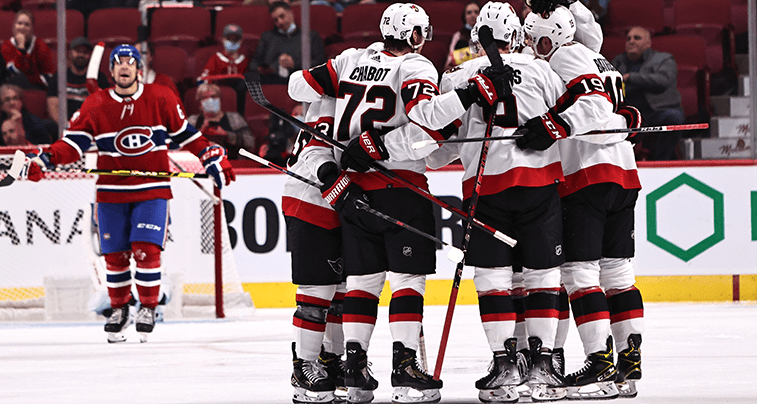McKenna: Analyzing How The Senators Have Improved Their Power Play

2020-21 was a long season for the Ottawa Senators.
Yet despite a disappointing 23-28-5 record that resulted in the Sens missing the playoffs for the fourth straight year, Ottawa steadily progressed throughout the season. After a horrendous 2-12-1 start to the season, the Senators went 21-16-4 the rest of the way.
Ottawa carried this momentum into the 2021-22 season by winning two of their first three games – impressively beating the Toronto Maple Leafs and Dallas Stars.
The Senators power-play has featured well and gives hope for things to come. After finishing 26th in the NHL at 15.5% with the man advantage in 2020-21, the Senators have gone 4-for-9 (44%) in the early going this season.
They’re on pace for 109 power-play goals. Obviously that’s not sustainable. But the Senators have scored at least one goal with the man advantage in all three of their games so far. And they will soon get another boost with the return of Brady Tkachuk, who scored 10 of the Senators’ 27 power-play goals last season.
So what are the Senators doing differently?
They’ve developed an attack mentality. And the Senators have done a much better job of establishing a net front presence. Both of which were lacking during the 2020-21 season.
It would be easy to call Tyler Ennis lucky on the Senators’ first power-play tally of the season. Thomas Chabot lofts a shot from the blue line, it deflects off Maple Leafs defenseman Justin Holl, then redirects a second time off of Ennis’ pants into the net.
Simple.
But details matter. The quick high-low-high exchange between Chabot and Tim Stutzle puts the Maple Leafs defense in motion. Holl ends up too high in his defensive zone, which opens up net front space for Ennis and Senators teammate Drake Batherson.
Even if the puck doesn’t go into the net off Ennis, the Leafs are at a disadvantage. They’re outnumbered down low and Jake Muzzin is unsure which Senators player to cover.
The last piece of the puzzle is Ennis’ timing. Notice he isn’t stationary. He’s in motion, circling around the low slot area. Only when the shot comes from Chabot does Ennis bolt to the front of the net.
Essentially what Ennis is doing is purposefully getting lost. Muzzin loses track of him. And the puck ends up behind Maple Leafs goaltender Jack Campbell.
There’s another factor in the Senators success thus far: young talent. Josh Norris and Drake Batherson are the real deal. Both scored 17 goals in 56 games last season. And they’re just now getting their feet underneath them at the NHL level.
Batherson’s feed to Norris is so crisp. The passing lane opened incredibly quickly and he was forced to thread the puck through several Maple Leafs defenders.
“It was a bit of a scrum for the puck and I realized both defensemen were near me.” Batherson explained to Daily Faceoff. “So I looked for Norris right away on the backside and was able to find a lane. Sometimes when there are scrambles for the puck, people get running around. Things tend to open up for a half second.”
That’s a confident play. Some players are afraid to make a mistake in that scenario. They don’t want to run the risk of turning the puck over. But Batherson sees Norris wide open and is willing to try.
And what a finish by Norris. Once he receives the pass, he’s got a clear lane to the net. But he’s looking backdoor and selling a pass. That bit of deception gets Campbell off balance and exposes the five-hole to Norris.
That’s heady hockey for a player entering his second NHL season.
The Senators have skill. And they’re also displaying a willingness to go to the net on the power-play.
Both of Chris Tierney’s goals are a result of getting to the blue paint. And he’s not alone: both times he has a Senators teammate within a stick-length. Tierney credited the attacking mindset of the Senators.
“I’ve just been trying to go to the net and find pucks around there. The first (goal) was a lucky bounce that came up and hit me in the chest” Tierney told Daily Faceoff. “The second one I came down the back door and took a hard pass from (Sanford) at the goal line. I tried to get a strong stick on the pass and pop it off.”
Credit is also due to Connor Brown. When he gets the puck on his stick during a power play, his natural instinct is to go downhill towards the net. That forward motion draws attention because Brown has options. He can pass down low to Sanford on the goal line. He can rip a seam cross-ice. And if nothing else is available, he can shoot. Brown knows teammates will be crashing the net.
After three games, the Senators are showing signs that their power play could be a handful all season. They’ve been successful thus far because of good habits and an influx of talented young players. Add Brady Tkachuk into the mix and things might get scary for the opposition.
The Senators have the tools. Now they just have to be consistent.